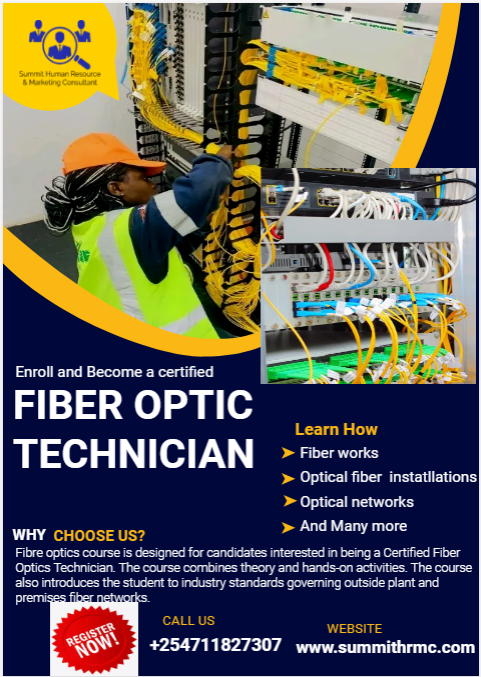email us: info@summithrmc.com
Course Overview
Fiber Optic course training is designed for anyone interested in becoming a Certified Fiber Optic Technician (CFOT). This course combines theory and hands-on activities. The course also introduces the participant to industry standards governing outside plant and premises fiber networks. Upon successful completion, the candidates will be issued with certificates.
Participant will be able to effectively and efficiently design, install, terminate, and test multimode/singlemode fiber optic networks.
Start date:
12th – 16th of August 2024
4PM – 7PM Daily
Duration & Training Format:
Instructor-Led Training Virtually (25hrs-30hrs) – on Google meet
[Virtual Classroom: 10 Days on weekdays Virtually then 2 Saturdays for practical]
Fees: Ksh 20,000 and an application fee of Kshs. 1,000 (non-refundable)
Paybill number 542542, Account 03403812596350,
I&M Bank, Eldama Ravine Branch, SUMMIT HUMAN RESOURCE & MARKETING CONSULTANT LTD
Core Areas to be Covered
1. How Fiber works, advantages and disadvantages of optical Fiber
2. Introduction to optical Fiber transmission systems
3. Manufacture of optical Fiber cables
4. Types, characteristics, classification and structure of optical Fibers
5. Optical devices
6. Optical Networks
7. Safety precautions
8. Optical Fiber installation methods 2 Certified Fiber Optic Technician (CFOT) Course
9. Optical Fiber splicing and termination methods
10. Optical Fiber link testing
11. Optical power budgeting calculations
12. Introduction to fiber-to-the-home.
13. Trouble shooting and maintenance procedures
Methodology
Lectures, PowerPoint Presentation, and hands on practical in splicing, connectorization, termination and testing. Along with chapter tests, class discussions, and substantial hands-on activities, the CFOT Test is given and graded at the end of the class. Participants will demonstrate the ability to build and test a fiber optic link.
Course Outline
Day 1
- Introduction to optic fiber.
- History of Fiber Optics.
- Theory of light.
- How fiber works,
- Fiber specifications (geometry, attenuation, bandwidth).
- Frequency spectrum and multiplexing (WDM
- Fiber Optics Safety.
- Terms and Definitions.
- Hands-on Session: view samples of fibers and cables.
Day 2
- How fiber optic links work (transmitter, receiver, power budget)
- Fiber Optic communication networks.
- Networks (telecom, data, CATV, etc.).
- Fiber optic technology and manufacture of optic fiber cable
- Preliminary planning and detailed survey
- Trenching
- Ducts and cable laying
- Standards and Code compliance.
- Reading prints and specs.
- Planning the installation.
- Pulling cable (installation hardware, guidelines to pulling, practices.
- Documentation.
Day 3
- Types of Cables.
- Cable preparation
- Connectarization.
- Fusion and mechanical splicing
- Hardware (patch panels, splice closures, conduit, etc)
- Hands on:
- Termination (one type, adhesive or prepolished/splice)
Day 4
- Continuity and tracing.
- Visual inspection of connectors and bare fiber.
- Loss with power meter and source.
- Hands on: Basic insertion loss testing with source and power meter
Day 5
- Fiber optic design and PON
- PON
- FTTX
- Maintenance of a fiber optic link
- OTDR techniques: Trouble shooting and service restoration
- Questions and answers
Registration: Still Open
Book your slot now; Call/Whatsapp +254711827307 or Email info@summithrmc.com




